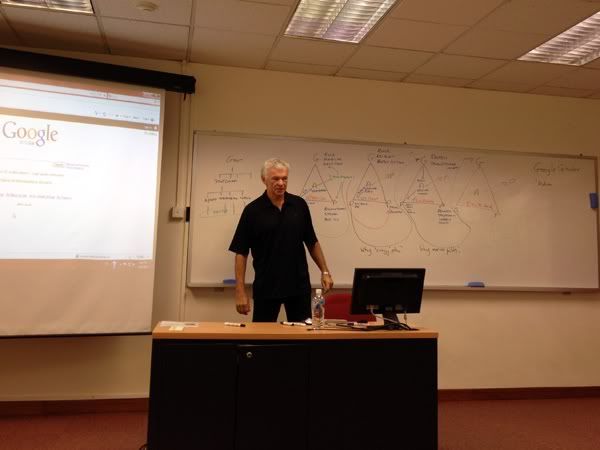There were 22 students for the subject held in Trimester 1 of 2012. This is one of the more comfortable size class I have attended so far. As such, I contributed frequently in class whenever the opportunity arises. The assessment allocation is 20% in-class case studies, 30% exams and 50% individual assignment. The subject is led by Dr Chris Smith. And the textbook used for the course is The Strategy Pathfinder. There are many live cases in the textbook which is a good read.
Intensive 1
We started on the Friday evening with a self-introduction. And we kick-off the lessons with an introduction into Strategy.
In the first intensive, we learnt about the Strategy Triangle covering Goals, Resources and Position. Thereafter we moved on into detail of Competitive Advantage (Differentiation and Cost Advantage), Positioning (Porter, Mintzberg, Bowman) and Resources (FNHO, VRIS). I find the 3 days lessons to be very well-structured and organised. There were many opportunities for students to participate. Dr Chris likewise asked some very deep-thinking questions. And there were scenario re-enactment. We explored what were each party considering at that point in time and the decision-making process. Strategic Management, being one of the tougher course in an MBA, is being taught by one of the best lecturer from Adelaide.
There were many opportunities for us to practise what we have learnt. It is not just theory but we have group discussion which covers 3 different case studies and 2 exercises, they are: The Iranian Hostage Crisis, US Apparel Industry in the late-80s, Toyota, Coca Cola and decreasing US spending. I find the case studies exercise to be very practical and it reinforces what we have learnt. In the same case studies group, we have Michael, Liu Yang, Kian Meng and Meena. Group synergy is quite strong with everyone providing different perspectives and willingness to evaluate our stand when a better one comes in.
The business concepts we have learnt previously in subjects such as Managerial Finance and Economics were used in this course. Many other companies were studied such as Coca Cola, Wal-Mart, Ryan Air, and so on.
I find the content and information provided in the first intensive to be perfect. It gave us enough exercises to reinforce and clarify any doubts we have. It is useful for us to apply in our individual assignment and perhaps for us to use in our work. Coincidentally, my job change last year placed me in a more strategic planning position and I understand the practical concepts which was taught.
Will look forward to the next intensive. Below is a photo of Dr Chris Smith explaining to us. (We are not recommended to use laptop, tablets or phone in class, which is very good - so we can concentrate fully in class).

Intensive 2
And now we are back to the second intensive on the 16th-18th weekend. We started by looking into the industry structure and what is considered to be strategic hell. The critical success factors of being in the game or win the game are discussed.
We went through many case studies analysis and discussion. The first of which is on McDonald's. And we have a sharing by Michael Porter below.
We have been taught to read critically. Even articles or books written by academics need to be questioned before accepting it one-off. We went through an article written by an academic which is based on incorrect assumptions and reasoning.
The notion of strategic groups were introduced and very detail coverage of the 5 forces were explained. Concepts explained in the strategic management course were put into practice through the case studies of the American Retail Banking industry, Motor industry in the US and McDonald's. The most interesting case study, which is out of the norm is the study of the drug industry. On how the distribution chain changes with police prosecution and the impact it has on the prices of drugs.
We finished the 2nd intensive with an interesting video of a corporate social responsibility video made by Nokia. They sent a consultant down to China to understand the factory environment and conditions of the workers. This video left quite a deep impression on me in understanding where does the things we use come from.
The strategic management class challenges all students to think critically, and we all have opportunity to discuss our ideas in class. The points brought across by the lecturer is concise and clear and we get to actually apply what was taught.